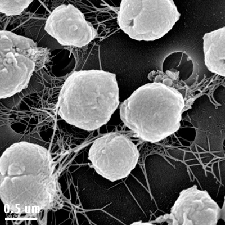Earth will always be the most accessible habitable planet for study. Consequently, studying the origin and earliest evolution of life, along with the long-term evolution of the Earth’s environments, helps us understand why the Earth became habitable and why terrestrial life has persisted for billions of years. The earliest environments on Earth are also very unlike our modern-day environment, and serve as alternate examples of “habitable planets.” Earth’s climate has been influenced by the Sun, which has gradually brightened by 25-30% in the last 4 billion years, and by the presence of greenhouse gases, many of which are produced by microbial life. UWAB research in this area combines expertise in geology, biology, chemistry, and atmospheric science, and takes UWAB faculty and students to remote locations such as Australia and Greenland, to examine the oldest and best-preserved rocks possible.
Evolution Of Bacteria
 In this research area, UWAB faculty and students use paleontology and stable-isotope geochemistry of ancient (Archean eon) sedimentary rocks to determine when the main forms of microbial metabolism arose and whether this caused environmental change in the atmosphere and oceans. Researchers also use organic geochemistry to study molecular fossils such as hydrocarbons and kerogen in ancient rocks (Archean and Paleoproterozoic eons), to discover hydrocarbon biomarkers that constrain the evolution of microbial ecosystems. Other UWAB researchers explore the role of viruses in microbial evolution in hydrothermal vent communities.
In this research area, UWAB faculty and students use paleontology and stable-isotope geochemistry of ancient (Archean eon) sedimentary rocks to determine when the main forms of microbial metabolism arose and whether this caused environmental change in the atmosphere and oceans. Researchers also use organic geochemistry to study molecular fossils such as hydrocarbons and kerogen in ancient rocks (Archean and Paleoproterozoic eons), to discover hydrocarbon biomarkers that constrain the evolution of microbial ecosystems. Other UWAB researchers explore the role of viruses in microbial evolution in hydrothermal vent communities.
Understanding Our Ancient Oceans And Atmospheres
 A significant focus of UWAB faculty and students is working to understand the nature of the Earth’s environment through time, and understanding how these environments affected life on the planet. UWAB researchers study the influx of nutrients to ancient oceans, measuring phosphorous and nitrogen geochemistry in sedimentary rocks through time, to determine whether these elements reflected or influenced ecosystem evolution. Constraining the Earth’s ancient atmospheric pressure and composition is also crucially important, as it helps us find explanations for how the Earth’s climate has remained clement for billions of years, even in the face of a much dimmer early Sun. UWAB efforts in this area include determining atmospheric composition during the Archean from sedimentology of heavy minerals from eroded rocks, and determination of atmospheric pressure on the Earth over 2 billion years ago using fossil raindrop imprints. UWAB faculty and students have also used a combination of computer models of biogeochemical cycles, and geological field data from ancient rocks, to understand the mechanisms for the rise of atmospheric oxygen 2.4 and 0.6 billion years ago. This rise altered Earth’s climate by chemically affecting greenhouse gas concentrations, and at the same time enabled the evolution of complex life.
A significant focus of UWAB faculty and students is working to understand the nature of the Earth’s environment through time, and understanding how these environments affected life on the planet. UWAB researchers study the influx of nutrients to ancient oceans, measuring phosphorous and nitrogen geochemistry in sedimentary rocks through time, to determine whether these elements reflected or influenced ecosystem evolution. Constraining the Earth’s ancient atmospheric pressure and composition is also crucially important, as it helps us find explanations for how the Earth’s climate has remained clement for billions of years, even in the face of a much dimmer early Sun. UWAB efforts in this area include determining atmospheric composition during the Archean from sedimentology of heavy minerals from eroded rocks, and determination of atmospheric pressure on the Earth over 2 billion years ago using fossil raindrop imprints. UWAB faculty and students have also used a combination of computer models of biogeochemical cycles, and geological field data from ancient rocks, to understand the mechanisms for the rise of atmospheric oxygen 2.4 and 0.6 billion years ago. This rise altered Earth’s climate by chemically affecting greenhouse gas concentrations, and at the same time enabled the evolution of complex life.
